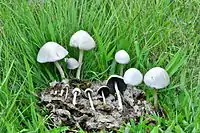Panaeolus antillarum
Panaeolus antillarum is a common and widely distributed small to medium-sized gray mushroom which grows on dung. It is edible but not commonly eaten. Found from northern North America through Mexico into northern South America.[1]
| Panaeolus antillarum | |
|---|---|
 | |
| Scientific classification | |
| Kingdom: | |
| Division: | |
| Class: | |
| Order: | |
| Family: | |
| Genus: | |
| Species: | P. antillarum |
| Binomial name | |
| Panaeolus antillarum (Fr.) Dennis | |
| Synonyms | |
|
Agaricus antillarum | |
| Panaeolus antillarum | |
|---|---|
float | |
| gills on hymenium | |
| cap is convex | |
| hymenium is adnexed | |
| stipe is bare | |
| spore print is black | |
| ecology is saprotrophic | |
| edibility: edible | |
It is often mistaken for Panaeolus semiovatus var. phalaenarum or Panaeolus cyanescens, the latter species can be distinguished by the thinner, grayer cap and blue bruising.
Description
- Cap: 3 to 6 cm, bell-shaped to convex, white to light gray or yellowish, The caps are thick, smooth, often with fine wrinkles and acquire a silver white shiny color in age.
- Gills: Gray in young specimens, turning black as the spores mature.
- Spore print: Jet black.
- Stipe: 4 to 22 cm long and .5 to 2 cm thick, solid, sometimes slightly larger at the base.
- Taste: Fungal.
- Odor: Fungal.
- Microscopic features: Spores ellipsoid, 15 - 20 (21) x 10 - 14 x 8 - 10(11) μm. Cheilocystidia cylindrical to narrowly utriform, colorless, 30 - 45 μm. Sulphidia clavate, sometimes with a stalk, 25 - 50 μm. Basidia four spored, 30 - 35 micrometers long.[2]
 Panaeolus antillarum
Panaeolus antillarum Panaeolus antillarum
Panaeolus antillarum
See also
References
- Stamets, Paul (1996). Psilocybin Mushrooms of the World. Berkeley: Ten Speed Press. ISBN 0-9610798-0-0.
- Gerhardt, Ewald. TAXONOMISCHE REVISION DER GATTUNGEN PANAEOLUS UND PANAEOLINA. ISBN 3-510-48018-X.
External links
This article is issued from Wikipedia. The text is licensed under Creative Commons - Attribution - Sharealike. Additional terms may apply for the media files.